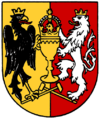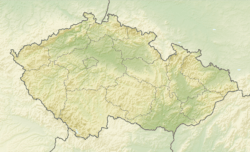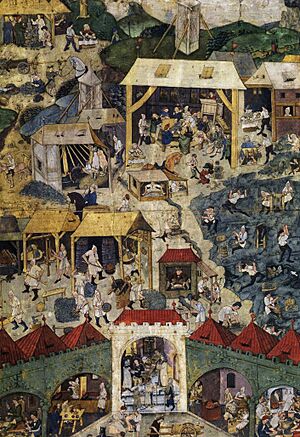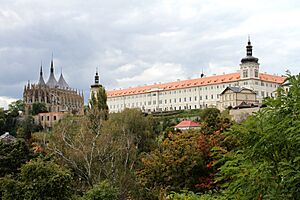Kutná Hora facts for kids
Quick facts for kids
Kutná Hora
|
|||
|---|---|---|---|
|
Town
|
|||

Vineyard of Kutná Hora
|
|||
|
|||
| Country | |||
| Region | Central Bohemian | ||
| District | Kutná Hora | ||
| First mentioned | 1289 | ||
| Area | |||
| • Total | 33.07 km2 (12.77 sq mi) | ||
| Elevation | 254 m (833 ft) | ||
| Population
(2024-01-01)
|
|||
| • Total | 21,556 | ||
| • Density | 651.83/km2 (1,688.23/sq mi) | ||
| Time zone | UTC+1 (CET) | ||
| • Summer (DST) | UTC+2 (CEST) | ||
| Postal code |
284 01
|
||
| UNESCO World Heritage Site | |||
| Official name | Historical Town Centre with the Church of St Barbara and the Cathedral of Our Lady at Sedlec | ||
| Criteria | ii, iv | ||
| Inscription | 1995 (19th Session) | ||
Kutná Hora is a historic town in the Central Bohemian Region of the Czech Republic. It is home to about 22,000 people. The town's center, including the Sedlec Abbey and its unique Sedlec Ossuary (a chapel decorated with human bones), became a UNESCO World Heritage Site in 1995. This was because of its amazing old buildings and how they influenced architecture in other cities in Central Europe. Since 1961, the town center has also been a protected "urban monument reservation," which is the fourth largest in the Czech Republic.
Contents
What's in a Name?
The name of the town, Kutná Hora, comes from the word hora, which means 'mountain'. There are old stories that say the name came from monks' Kutten (cowl, a type of hood). But it's more likely that the name came from an old German word, kutte, meaning 'pit'. Another idea is that it comes from Czech words like kutit ('to work') or kutat ('to mine').
Where is Kutná Hora?
Kutná Hora is located about 52 kilometers (32 miles) east of Prague, the capital city. The eastern part of the town is a flat area with farms. The western part has hills, and the highest point is Malý Kuklík hill, which is 359 meters (1,178 feet) above sea level. A stream called Vrchlice flows through the town.
A Look Back in Time: Kutná Hora's History
Early Days: Bronze and Iron Ages
Long, long ago, during the Bronze Age and Iron Age, people lived in the area around Kaňk hill. These were Celts, and archaeologists have found many old pottery pieces from their settlements. In 1981, they even found an ancient furnace with metal waste, showing that people were already mining in Kaňk hill around 200-100 BC.
How the Town Started
The first signs of silver in this area date back to the 10th century. At that time, Bohemia was a busy place for trade. Silver coins from the late 900s were found in a settlement called Malín, which is now part of Kutná Hora.
The town officially began in 1142 with the founding of Sedlec Abbey. This was the first Cistercian monastery in Bohemia. Around 1260, German miners started digging for silver in the mountains. They called the area Kuttenberg, and it was part of the monastery's land.
The Middle Ages: A Rich and Important Town
From the 13th to the 16th centuries, Kutná Hora was a very important town. It was so powerful that it even competed with Prague in business, culture, and politics. The silver mines brought a lot of wealth to the area, especially during a time when the economy was growing fast.
In 1300, King Wenceslaus II of Bohemia created a new set of rules for mining. This document, called Ius regale montanorum, explained everything needed to run the mines. From 1300 to 1547, a special coin called the Prague groschen was made here.
Kutná Hora became a favorite home for several Bohemian kings. In 1409, King Wenceslaus IV signed the famous Decree of Kutná Hora here. This decree gave Czech students more power at Prague University.
During the Hussite Wars in the 1400s, Kutná Hora was a key battleground. In 1420, King Sigismund used the town as a base to attack the Taborites, a group of Hussite warriors. The town was captured by Jan Žižka, a famous Hussite leader. Later, it was burned by imperial troops to keep it from falling into enemy hands again. But Žižka took it back, and the town began to thrive once more.
Modern Times
In 1526, Kutná Hora became part of the Habsburg monarchy (which later became the Austrian Empire). In 1546, a major mine was flooded, causing problems. When Bohemia rebelled against Ferdinand I, Kutná Hora lost many of its special rights.
The town suffered from repeated outbreaks of the plague and the terrible Thirty Years' War. These events caused a lot of damage. Attempts to fix the mines after the war failed, and the town became poor. In 1770, a big fire destroyed much of it. The mines were finally closed at the end of the 18th century.
In 1918, after World War I, Kutná Hora became part of the new country of Czechoslovakia.
Population
As of 2024, Kutná Hora has a population of about 21,556 people.
Places to See
One of the most famous places is Sedlec Ossuary. This chapel is decorated with the bones of more than 40,000 skeletons! It's a very unique and interesting place.
Another important building is the Gothic St. Barbara's Church. It has five naves (long sections) and was started in 1388. The Italian Court is also a must-see. It used to be a royal home and a place where coins were made. It was built in the late 1200s.
The Gothic Stone House, which is now a museum about silver, holds many important historical records. The Gothic Church of Saint James the Great is also very tall, with a tower that is 86 meters (282 feet) high.
Other interesting places to visit include:
- Jesuit College
- Plague Column (a monument built to remember people who died from the plague)
- Church of St. John of Nepomuk
- Church of Saint Ursula's Convent
- Church of Saint Stephan in Malín
Images for kids
-
Black Death memorial
See also
 In Spanish: Kutná Hora para niños
In Spanish: Kutná Hora para niños














